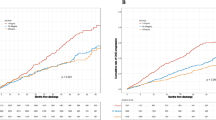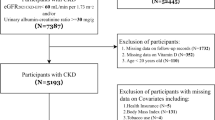Summary
The effect of 1,25-dihydroxyvitamin D3 (1,25(OH)2D3) and of two synthetic analogs, 1,25S,26-tri-hydroxy-Δ22-vitamin D3 (1,25,26(OH)3-22ene-D3, Ro 23-4319) and 1,25-dihydroxy-Δ16-23yne-vitamin D3 (1,25(OH)2-16ene-23yne-D3, Ro 23-7553) on cell growth was evaluated by determination of [3H]thymidine incorporation into DNA of human colon adenocarcinomaderived Caco-2 cells. The extent of growth inhibition by the vitamin D compounds varied between 20–40% (at 10−8 M), depending on particular growth conditions of Caco-2 cells as well as on the molecular structure of the vitamin D sterols. In confluent, i.e., rather quiescent cells, all three vitamin D compounds were equipotent in suppressing growth. In rapidly dividing log phase cells, 1,25(OH)2-16ene-23yne-D3 or 1,25,26(OH)3-22ene-D3 were ten or five times, respectively, more efficient than 1,25(OH)2D3. A substantial effect on induction of the colonocyte differentiation marker alkaline phosphatase was only elicited by 1,25(OH)2-16ene-23yne-D3.
The ability of the vitamin D compounds to raise intestinal calcium absorption was evaluated by determination of 45Ca2+ accumulation in embryonic chick duodenal explants. In this assay, both synthetic analogs were less effective than 1,25(OH)2D3 by a factor of 20.
The intrinsic bone resorbing activities of the vitamin D analogs were compared in organ-cultured neonatal mouse calvariae. The most effective antiproliferative compound, 1,25(OH)2-16ene-23yene-D3, stimulated calcium release from cultured bones at concentrations less than 10−11 M, and was thus ten times more potent than 1,25(OH)2D3 and hundred times more than 1,25,26-(OH)3-22ene-D3.
Similar content being viewed by others
References
Bouillon R, Allewaert K, Xiang DZ, Tan BK, van Baelen H (1991) Vitamin D analogs with low affinity for the vitamin D binding protein: enhanced in vitro and decreased in vivo activity. J Bone Min Res 6:1051–1057
Corradino RA (1973) Embryonic chick intestine in organ culture: A unique system for the study of intestinal calcium absorptive mechanism. J Cell Biol 58:64–78
Cross HS, Mayerhofer L, Peterlik M (1991 a) Differentiation-related effects of 1,25-dihydroxycholecalciferol on intestinal epithelial cells: auxiliary role of triiodothyronine. In: Norman AW, Bouillon R, Thomasset M (eds) Vitamin D. Gene regulation, structure-function analysis and clinical application. Walter de Gruyter, Berlin-New York, pp 411–412
Cross HS, Huber C, Peterlik M (1991 b) Antiproliferative effect of 1,25-dihydroxyvitamin D3 and its analogs on human colon adenocarcinoma cells (Caco-2). Influence of extracellualr calcium. Biochem Biophys Res Commun 179:57–62
Cross HS, Pavelka M, Slavik J, Peterlik M (1992) Growth control of human colon cancer cells by vitamin D and calcium in vitro. J Natl Cancer Inst 84:1355–1357
Denizot F, Lang R (1986) Rapid colorimetric assay for cell growth and survival. Modifications to the tetrazolium dye procedure giving improved sensitivity and reliability. J Immunol Methods 89:271–277
Dusso AS, Negrea L, Gunawardhana S, Lopez-Hilker S, Finch J, Mori T, Nishii Y, Slatopolsky E, Brown AJ (1991) On the mechanisms for the selective action of vitamin D analogs. Endocrinology 128:1687–1692
Farach-Carson MC, Sergeev I, Zhou L-X, Norman AW (1991) Nongenomic actions of 1,25(OH)2D3 in rat osteosarcoma cells and chick intestinal epithelial cells: structure function studies of ligand agonist actions. In: Norman AW, Bouillon R, Thomasset M (eds) Vitamin D. Gene regulation, structure-function analysis and clinical application. Walter de Gruyter, Berlin-New York, pp 157–158
Forstner GG, Sabesin SM, Isselbacher KJ (1968) Rat intestinal microvillus membranes. Purification and biochemical characterization. Biochem J 106:381–390
Franceschi RT, DeLuca HF (1981 a) Characterization of 1,25-dihydroxyvitamin D3-dependent calcium uptake in cultured embryonic chick duodenum. J Biol Chem 256:3840–3847
Franceschi RT, DeLuca HF (1981 b) The effect of inhibitors of protein and RNA synthesis on 1,25-dihydroxyvitamin D3-dependent calcium uptake in cultured embryonic chick duodenum. J Biol Chem 256:3848–3852
Giuliano AR, Franceschi RT, Wood RJ (1991) Characterization of the vitamin D receptor from the Caco-2 human colon carcinoma cell line: effect of cellular differentiation. Arch Biochem Biophys 285:261–269
Kistler A, Galli B, Horst R, Truitt GA, Uskoković MR (1989) Effects of vitamin D derivatives on soft tissue calcification in neonatal and calcium mobilization in adult rats. Arch Toxicol 63:394–400
Lerner UH (1987) Modifications of the mouse calvarial technique improve the responsiveness to stimulators of bone resorption. J Bone Min Res 2:375–383
Minghetti PP, Norman AW (1988) 1,25-(OH)2 Vitamin D3 receptors: gene regulation and genetic circuitry. FASEB J 2:3043–3053
Mosmann T (1983) Rapic colorimetric assay for cellular growth and survival: application to proliferation and cytotoxicity assays. J Immunol Methods 65:55–63
Morrison NA, Eisman JA (1991) Nonhypercalcemic 1,25-(OH)2D3 analogs potently induce the human osteocalcin gene promoter stably transfected into rat osteosarcoma cells (ROSCO-2). J Bone Min Res 6:893–899
Norman AW, Koeffler HP, Bishop JE, Collins ED, Sergeev I, Zhou L-X, Nemere I, Zhou J, Henry HL, Okamura WH (1991) Structure-function relationships in the vitamin D endocrine system for 1,25(OH)2D3 analogs. In: Norman AW, Bouillon R, Thomasset M (eds) Vitamin D. Gene regulation, structure-function analysis and clinical application. Walter de Gruyter, Berlin-New York, pp 146–154
Pinto M, Robine-Leon S, Appay M-D, Kedinger M, Triadou N, Dussaulz E, Lacroix B, Simon-Assman P, Haffen K, Fogh J, Zweibaum A (1983) Enterocyte-like differentiation and polarization of the human colon carcinoma cell line Caco-2 in culture. Biol Cell 47:323–330
Schwartz B, Avivi C, Lamprecht SA (1991) Isolation and characterization of normal and neoplastic colonic epithelial cell populations. Gastroenterology 100:692–702
Stern PH, Krieger NS (1983) Comparison of fetal rat limb bones and neonatal mouse calvaria: Effects of parathyroid hormone and 1,25-dihydroxyvitamin D3. Calcif Tissue Int 35:172–176
Tomon M, Tenenhouse HS, Jones G (1990) Expression of 25-hydroxyvitamin D3-24-hydroxylase activity in Caco-2 cells. An in vitro model of intestinal vitamin D catabolism. Endocrinology 126:2868–2875
Zhou JY, Norman AW, Lübbert M, Collins ED, Uskoković MR, Koeffler HP (1989) Novel vitamin D analogs that modulate leukemic cell growth and differentiation with little effect on either intestinal calcium absorption or bone calcium mobilization. Blood 74:82–93
Zhou JY, Norman AW, Chen DL, Sun GW, Uskoković M, Koeffler HP (1990) 1,25-Dihydroxy-16-ene-23-yne-vitamin D3 prolongs survival time of leukemic mice. Proc Natl Acad Sci USA 87:3929–3932
Author information
Authors and Affiliations
Additional information
A preliminary report of this study was presented at the International Conference on Calcium Regulating Hormones, April 24–29, 1992, Florence, Italy
Correspondence to M. Peterlik at the above address
Rights and permissions
About this article
Cite this article
Cross, H.S., Farsoudi, K.H. & Peterlik, M. Growth inhibition of human colon adenocarcinoma-derived Caco-2 cells by 1,25-dihydroxyvitamin D3 and two synthetic analogs: relation to in vitro hypercalcemic potential. Naunyn-Schmiedeberg's Arch Pharmacol 347, 105–110 (1993). https://doi.org/10.1007/BF00168780
Received:
Accepted:
Issue Date:
DOI: https://doi.org/10.1007/BF00168780




